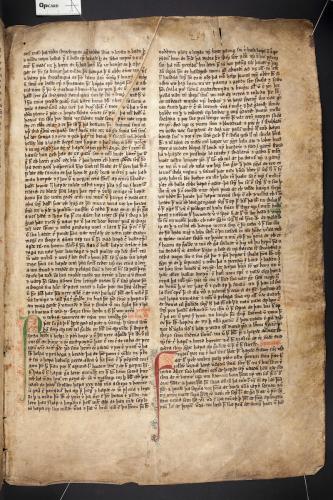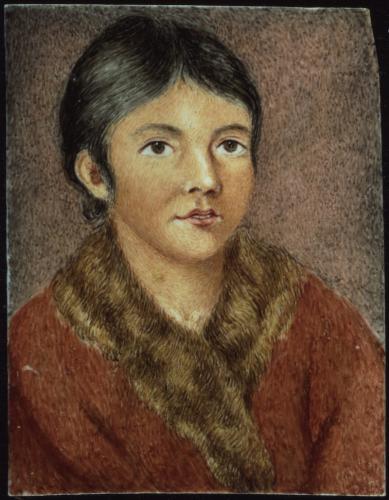The first recorded conversation between a European and a North American native may have lain hidden for 1,000 years in a puzzling anecdote in Iceland’s Vinland sagas, in a passage generally ignored or dismissed as a Norse ghost story. This is the story of Gudrid, a leader of a Norse colonizing party, and her mysterious visitor, also named Gudrid, at Leif Ericson’s outpost in what is now called Newfoundland.
Gudrid, wife of the expedition leader Thorfinn Karlsefni, widow of a brother of Leif Erikson and herself a prime mover in the west-ward explorations, is sitting with her newborn son as the Norse trade with the Natives outside their settlement palisades. A mysterious woman suddenly appears and addresses her in Norse. Gudrid introduces herself, and the visitor replies, “My name is Gudrid.” Then this second Gudrid suddenly disappears.
Their brief conversation around the year 1016 A.D. has inspired a range of literary and folkloric explanations and caused at least one scholar to call it inexplicable. Yet in the last two decades a simple explanation has gained currency. Gudrid’s visitor was not a ghost or companion spirit, the traditional explanation, but a curious Native girl exploring the strange settlement. This scenario not only rings true from the Native perspective, it suggests that the saga records nearly verbatim a scene of First Contact.
This approach also underscores the value of often disregarded medieval sources for in-sights into European awareness of a western landmass, and its inhabitants, in the centuries before Columbus. The “discovery” of America in 1492 now looks less like a single dramatic breakthrough than like the culmination of a long, gradual European expansion across the Atlantic.
Gudrid the Voyager
Certainly the Norse sagas contain fantastic elements. The corpse of a newly deceased husband sits up and begins to prophesy. The leader of a Vinland expedition is slain by a Uniped out of medieval travel mythology. But more and more of this remarkable body of literature is proving to have a solid historical base. And Gudrid herself is one of its best-documented figures.
Gudrid Thorbjarnardottir (985?–1050?) has been called the best-travelled woman of the Middle Ages. She was born in Iceland circa 985, gave birth to a son in Vinland and later in life made a pilgrimage to Rome, returning to Iceland as a religious recluse who founded a major convent. She is a major figure in the Saga of the Greenlanders, which calls her “a woman of striking appearance and wise as well, who knew how to behave among strangers.”
Gudrid’s family were Gaelic retainers in the retinue of Unn (or Aud) the Deep-Minded, a formidable Norwegian matriarch and discarded wife of a Viking king of Dublin, who emigrated to Iceland around 900 to escape the enmity of the new King of Norway. Once there, Unn claimed an unsettled valley and distributed farms to her followers, including Gudrid’s grandfather. This genealogy provides the opening of the Saga of Erik the Red, the second of the so-called “Vinland” sagas.
Although Erik and his son Leif are the famous names in the westward push to America, it’s clear from the sagas that Gudrid and her family did far more to keep the story alive. Erik himself and the founding of Greenland come in only in the second chapter of his own saga, and his alliance with Gudrid’s family is emphasized throughout. The focus quickly returns to Gudrid, to the extent that the work could more accurately be called Gudrid’s Saga. The two Vinland sagas have variant accounts of the voyages to the West and of Gudrid’s several marriages, but they both end by recounting the descendants of her final marriage, to Thorfinn Karlsefni, which included three bishops of Iceland. The Greenlanders’ Saga says explicitly, “It was Karlsefni who gave the most extensive reports of anyone of all these voyages, some of which have now been set down in writing.”
The incident that concerns us appears in Chapter 6 of the Greenlanders’ Saga, during Karlsefni’s attempt to settle at the outpost established by Leif Eriksson. “Leif’s booths,” as the saga calls the compound of thatched buildings built by Leif’s earlier expedition, are now convincingly identified as the Norse remains at L’Anse aux Meadows in northern Newfoundland. Karlsefni and his crew pushed south, possibly setting up camp in southwest Newfoundland, at or near the putative Norse site recently discovered with much fanfare. This second site was closer to the area frequented by the indigenous population, believed to be the Beothuk tribe. It’s not clear from the saga whether Gudrid went south or stayed at “Leif’s booths.”
At the beginning of the second winter of the expedition, natives (called the Skraelings by the Norse) come to the Norse palisades (in whichever location) to trade, as they had the year before. Gudrid sits inside the door with the cradle of her year-old son Snorri (as far as we know the first European child born in the New World).
To quote the recent translation by Keneva Kunz, (in The Sagas of Icelanders, Penguin, 1997):
A shadow fell across the doorway and a woman entered, rather short in stature, wearing a close-fitting tunic, with a shawl over her head and light red-brown hair. She was pale and had eyes so large that eyes of such size had never been seen in a human head.
She came to where Gudrid was sitting and spoke: “What is your name,” she said.
“My name is Gudrid and what is yours?”
“My name is Gudrid,” the other woman said.
Gudrid, Karlsefni’s wife, then motioned to her with her hand to sit down beside her but just as she did so, a great crash was heard and the woman disappeared.
The trading session outside had ended badly, as one of the natives had tried to take a Norse weapon and been killed. Only Gudrid had seen the woman.
Up until the turn of this millennium, the visit was generally dismissed as supernatural, a ghost story from the strange new land. How else could the woman converse in Norse and give her name as Gudrid? With its deft use of detail, the saga underscores the anomaly by observing several lines earlier that neither Norse nor Skraeling “understood the language of the other.”
But another explanation emerged in 1999 at a conference in Reykjavik on the millennium of Leif Ericson’s voyages. A paper by the late scholar Bo Almquist, subsequently printed in the conference report Approaches to Vinland (University of Iceland Press, 2001) portrays the visit as an actual encounter between Gudrid and a Beothuk woman or girl.
Allowing for exaggerations, the description, including the close observation of the wardrobe, fits later images of Beothuk girls. The Beothuk were the main tribe in Newfoundland at the time, later supplanted by the Mi’kmaq. Although adult clothing was considerably different, young girls appear to wear close-fitting shirts or shawls around their torsos. An early 19th century drawing by one of the last surviving Beothuks, Shanawdithit, or Nancy April, shows a girl wearing a ceremonial outfit, the tail of which could easily be flipped over her head.
The reddish-brown hair could be explained by the red ocher the Beothuk used for decoration. The Saga’s earlier description of the Skraelings emphasizes their large eyes.
The difficulty, of course, is the conversation itself. How could the girl have initiated it with a question in Old Norse? If we slightly alter the sequence, all of a sudden we have a plausible scenario. If the later writer of the saga had the girl speak first, or even if Gudrid interpreted something the girl said as a friendly question, we have the encounter beginning with the Norse woman, who knew how to behave among strangers, saying in a friendly tone, “My name is Gudrid.” (Ek heiti Gudridr.) The native girl then repeats the sentence.
We have suddenly left the spectral arena and have an exchange that rings as true as a transcript. A feature of first contact noted by other Europeans was the ability of American Natives to mimic their speech. Even long sentences could be repeated verbatim with perfect accents. When Bartholomew Gosnold visited what is now Martha’s Vineyard in 1602, John Brereton, one of his crew, was astonished at how quickly an Indian friend learned to mimic his statement, “How now, sirrah, are you so saucie with my tobacco?”
This mysterious episode now looks like an actual, and rather poignant, encounter, very likely directly recounted by Gudrid herself. It is even more convincing as we peel away the spooky storytelling. A young Native girl accompanying the trading party is driven by curiosity to sneak inside the strangers’ camp. She finds a reassuring sight, a young mother with an infant. She mimics the strange but friendly words the woman is saying. But a sudden alarm from outside abruptly interrupts, and the young girl quickly flees, as unseen as when she came.
A recent biographer of Gudrid Thorbjarnardottir (Nancy Marie Brown in The Far Traveller, Harcourt Books, 2007) speculates about the woman’s annoyed reaction to the way the men were ruining things. Relations with the Skraelings quickly deteriorated and soon forced Karlsefni to abandon his colony. The friendly exchange of Gudrid with her visitor was only a fleeting alternative, soon dismissed as supernatural.
We thank Dr. Gisli Sigurdsson and Haukur Thorgeirsson for their help and courteous reception at the Arni Magnusson Institute for Icelandic Studies in Reykjavik, Iceland.



